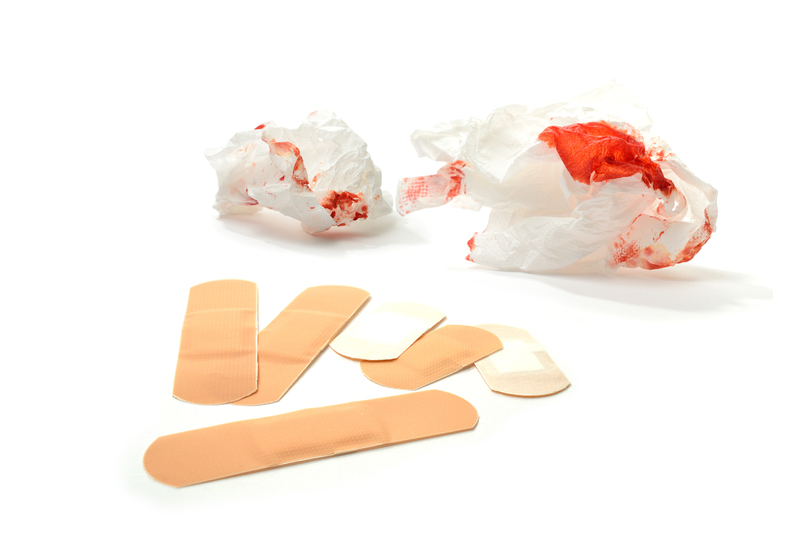Transform Your Space: Eliminate Damp Odors
Posted on 24/08/2025
Transform Your Space: Eliminate Damp Odors for Good
Is a musty, damp smell clinging to your space? Damp odors are not only unpleasant--they can also signal hidden issues like excess moisture, mold, or poor ventilation. Learning how to eliminate damp odors is essential for turning your home or office into a fresh, inviting environment. In this comprehensive guide, we'll explore proven strategies and solutions to transform your space and eradicate those stubborn musty and damp smells.

Understanding Damp Odors: What Causes That Musty Smell?
Damp odors often point to underlying problems. Before you can eliminate damp odors from your living spaces, it's vital to understand what causes them. Here are the most common culprits:
- Excess Moisture: High humidity or water leaks introduce extra moisture that can get trapped in walls, floors, and furniture.
- Poor Ventilation: Spaces that don't get enough airflow allow moisture and air contaminants to linger, making it harder for damp smells to escape.
- Mold and Mildew: These fungi thrive in damp, dark places and are a major source of musty, unpleasant odors.
- Water Damage: A history of flooding, roof leaks, or plumbing issues can saturate porous materials with moisture, leading to persistent damp smells.
Understanding these root causes is the first step in making your space smell fresh and inviting again.
Signs Your Space Needs Damp Odor Elimination
It's not always easy to pinpoint where the odor is coming from, especially in large or cluttered areas. Here are common warning signs that your space needs intervention:
- Persistent musty scent when you enter a room
- Mold spots or discoloration on walls, ceilings, or furniture
- Condensation on windows or walls, particularly in corners or closets
- Warping wood, peeling paint, or bubbling wallpaper
- Allergy-like symptoms among household members (sneezing, coughing, watery eyes)
If you notice any of these signs, it's time to eliminate damp odors and protect your home and health.
Step-by-Step: How to Eliminate Damp Odors from Your Home
1. Find and Fix the Source of Moisture
You can't erase the smell without addressing the cause! Begin your transformation by following these investigative steps:
- Inspect for leaks: Check under sinks, around windows, and in basements, attics, or crawlspaces for signs of water ingress.
- Examine your roof and foundation: Roof leaks, gutter clogs, or foundation cracks can be sneaky sources of water.
- Fix plumbing issues swiftly: Dripping pipes or slow leaks can saturate nearby surfaces and spread dampness.
- Address external drainage: Make sure soil and landscaping direct water away from your home's foundation.
By eliminating the source of moisture, you stop damp odors from returning after cleanup.
2. Improve Ventilation and Airflow
Sometimes, all you need to eliminate damp odors is a breath of fresh air. Improving airflow clears out stale, humid air and discourages mold growth. Try these solutions:
- Open windows and doors regularly, especially after showers, cooking, or cleaning.
- Install exhaust fans in bathrooms, kitchens, and laundry rooms.
- Use ceiling or portable fans to circulate air throughout your home.
- If you have a basement, run a dehumidifier to lower humidity levels (ideal indoor humidity is 30-50%).
3. Deep Clean Affected Areas
Dirt, dust, and organic materials (like pet hair or old carpets) can harbor moisture and foster the growth of odor-causing mold and bacteria. Deep cleaning is a crucial step to permanently eliminate musty smells:
- Shampoo or replace carpets and rugs prone to absorbing moisture.
- Wipe down all surfaces with a mixture of water and white vinegar or baking soda--both are natural deodorizers and mold combatants.
- Clean washable curtains, bedding, and cushions.
- If mold is present, treat hard surfaces with a solution of 1 cup bleach in 1 gallon of water. Always wear gloves and masks when cleaning mold.
For persistent or widespread mold, consider professional remediation.
4. Dry Out Your Space Quickly
Moisture is the enemy. After cleaning, make sure your home is thoroughly dry to avoid recurring damp smells:
- Run dehumidifiers or air conditioning to remove moisture from the air.
- Hang wet items outdoors in sunlight whenever possible--UV rays help kill mold spores.
- Invest in moisture-absorbing products like silica gel, activated charcoal, or calcium chloride in closets and under sinks.
5. Use Odor Neutralizers and Natural Remedies
After tackling the sources and cleaning thoroughly, you're ready for the final step to completely eliminate damp odors. Both store-bought and natural solutions can help, including:
- Baking soda: Powerful and inexpensive, baking soda is a classic deodorizer. Place open bowls or sprinkle on carpets before vacuuming.
- Activated charcoal: Traps moisture and odors; available in breathable fabric bags for closets, shoes, and small rooms.
- White vinegar: Absorbs smells--simply set out a bowl or spray diluted vinegar directly onto problem areas.
- Essential oils: Add a few drops to a diffuser for a lasting, natural fragrance. Popular choices include tea tree, lavender, and eucalyptus.
- Commercial odor absorbers: Products like DampRid or Febreze can give rooms an instant refresh while you solve underlying issues.
Long-Term Strategies to Prevent Damp Odors from Returning
Once you've succeeded in eliminating damp odors, keep them away for good with these lasting habits:
- Keep humidity in check: Use dehumidifiers or air conditioners in humid months, and ventilate after activities producing moisture, like showers or cooking.
- Store items properly: Avoid storing clothes, books, or boxes directly on basement or attic floors. Use shelves or airtight bins.
- Keep gutters clean: Regularly remove leaves and debris from gutters and downspouts to prevent overflow and leaks.
- Seal vulnerable areas: Weatherproof windows, doors, and walls to stop water and humid air from getting inside.
- Regular inspections: Set seasonal reminders to check for leaks, mold spots, or condensation so you can catch problems early.
Common Questions about Getting Rid of Damp Smells
How long does it take to eliminate damp odors?
The timeframe depends on the source and severity of the smell. Minor odors from a brief humidity spike may clear in hours with ventilation, while deeper issues like water damage or mold infestations may take days or weeks--or require professional help.
Are air fresheners enough to mask damp or musty smells?
No--covering odors is not enough! Air fresheners can mask bad smells temporarily but will not fix the underlying issue. True relief comes from eliminating the source of dampness and odors through repairs, cleaning, and proper circulation.
Is it safe to clean mold myself?
For small areas, DIY cleaning is generally safe with gloves and a mask. If you see extensive mold growth or experience respiratory symptoms, it's safer and more effective to hire a professional mold remediation service.
What are the health risks of ignoring damp odors?
Damp, musty odors often signal the presence of mold, which can cause:
- Allergic reactions (sneezing, itching, watery eyes)
- Asthma attacks or breathing problems
- Weakened immune response in susceptible people
- Structural damage to your home over time
That's why it's important not only to eliminate damp odors but to address the root causes for both health and home safety.
Damp Odor Solutions for Specific Spaces
How to Eliminate Damp Odors in Basements
Basements are notorious for damp, musty smells due to their below-ground position and poor ventilation. To tackle basement odors:
- Ensure walls and floors are waterproofed; apply sealant if needed.
- Install a high-capacity dehumidifier and check it regularly.
- Fix any foundation cracks to prevent leaks.
- Use moisture absorbers in corners or closets.
- Regularly inspect sump pumps and floor drains for blockages.
Eliminating Musty Smells in Bathrooms
Bathrooms are humid and often host mildew or bad plumbing smells. Effective elimination:
- Clean grout and tiles weekly with an anti-mold solution.
- Use an exhaust fan during and after showers.
- Replace shower curtains or liners regularly.
- Fix leaky faucets or pipes at the first sign.
- Hang towels to dry outside the bathroom when possible.
How to Remove Damp Odors from Closets and Cabinets
These small, closed-off areas tend to trap humidity, encouraging mold and mildew. To eliminate closet or cabinet odors:
- Keep doors slightly ajar when possible for ventilation.
- Use silica gel packs, baking soda, or charcoal bags inside.
- Wipe surfaces with white vinegar twice per year.
- Avoid over-packing to permit airflow around fabrics or items.

Best Products to Eliminate Damp Odors Permanently
While many home remedies help, some commercial products are designed specifically to eliminate damp and musty smells:
- DampRid Moisture Absorber: Ideal for closets, RVs, and basements.
- HEPA Air Purifiers: Traps airborne spores and allergens.
- Mold/Mildew Remover Sprays: Kills and prevents odor-causing fungi.
- Odor-absorbing crystals or gels: Easy to use for ongoing freshness.
- Dehumidifiers: Maintain optimal humidity 24/7 in trouble areas.
Read product reviews and choose items suited for your room size and odor severity for best results.
Final Thoughts: Enjoy a Fresh, Odor-Free Space
Musty, damp smells can make your living space uncomfortable and even threaten your health over time. By finding and fixing moisture sources, cleaning thoroughly, improving ventilation, and using the right odor-fighting products and habits, you can eliminate damp odors once and for all. Transform your space today--enjoy clean, fresh air and the peace of mind that comes from a healthy home!
If damp odors persist after following these steps, consult with a professional to rule out hidden leaks or mold issues. Don't let musty smells take over your space--take charge and breathe easy again!




